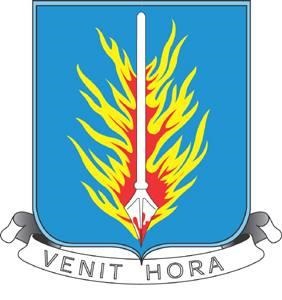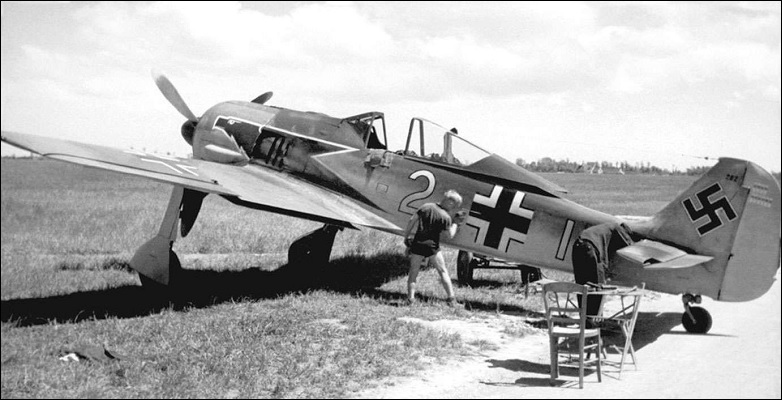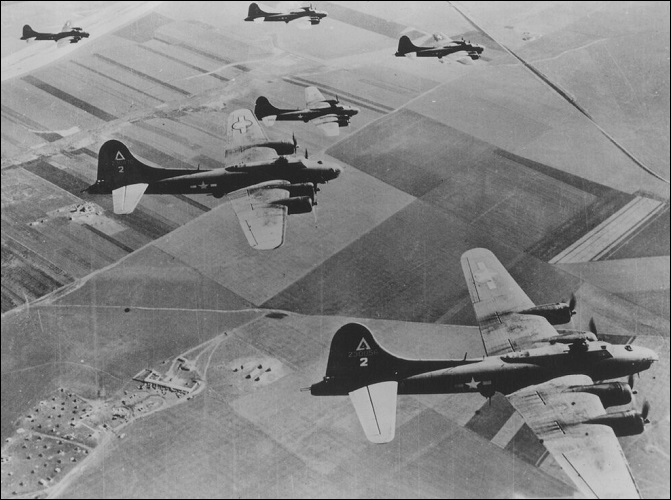● ● ●
The US Eighth Air Force commenced
operations in the summer of 1942, and during the year that
followed the stage was set for Operation POINTBLANK: the
Combined Bomber Offensive that would crush the Luftwaffe and
devastate urban Germany. For RAF Bomber Command, the prelude
to Pointblank was a period of consolidation. Though large
raids continued to be launched, the command’s operational
tempo slowed somewhat as new aircraft were introduced,
lessons were digested and tactics were refined. But for the
Americans, it was a baptism of fire and an opportunity to
show that the concept of daylight precision bombing was
viable.
The very first combat mission to be
conducted by Eighth Air Force was largely symbolic—as its
date, 4 July 1942, indicated. The mission was flown by the
15th Bombardment Squadron (Light) (Separate), whose
personnel had arrived in Britain without their own aircraft.
For the Fourth of July mission, the 15th borrowed a number
of Boston light bombers, these being the Lend-Lease version
of the A-20 light bomber with which the squadron was
intended to be equipped. The RAF provided invaluable
training to the 15th’s combat crews, six of which were
selected to join six RAF Bostons in a low-level attack
against German airfields in Holland.
Tactically, this first Eighth Air
Force mission was nothing to boast about. Only two of the
American Bostons bombed their assigned targets, two others
were shot down by flak (antiaircraft fire), and another was
badly damaged. But there was one notable incident. The
Boston piloted by Captain Charles Kegelman was hit by flak
that damaged its right engine and wing, lost altitude and
actually struck the ground. But the bomber bounced back up
and Kegelman managed to keep it in the air. Then, as he
turned for home, the guns of a German flak tower opened fire
on his plane. Kegelman turned, flew toward the tower and
shot it up with his nose guns. The German gunners ceased
fire and dived for cover. Kegelman then brought his damaged
Boston back to base, flying at very low altitude across the
English Channel. He was subsequently awarded the
Distinguished Service Cross. The 15th flew another combat
mission on 12 July, this time attacking at medium altitude
with no losses. Shortly thereafter its A-20s had arrived
from the United States and the squadron spent the next few
weeks making them operational.

The Hour Has Come:
Distinctive Unit Insignia of the 97th Bombardment Group
(American Air Museum in Britain)
So the Americans entered the
battle—if only symbolically— as meanwhile the combat crews
of the 97th Bombardment Group (Heavy) completed their
training. By 15 August twenty-five crews were declared ready
for daylight bombing missions. The commitment of these crews
and their B-17s would mark the real beginning of the
American daylight bombing offensive and it only remained to
select a suitable target. At this stage an attack deep into
Germany itself was obviously out of the question; the target
would have to be within the range of fighter escort. The
choice fell on the Sotteville railroad marshaling yard at
Rouen in Normandy, an important transportation hub. The
attack would be delivered by twelve B-17s in two six-plane
flights, with another six flying a diversionary mission off
the coast. Nine Spitfire squadrons of RAF Fighter Command
would provide the fighter escort. The attack was scheduled
for 17 August, aircraft to begin taking off from Grafton
Underwood at 1530 hours. Major General Ira Eaker, now
commanding VIII Bomber Command, would ride along in
Yankee Doodle, lead bomber of the second flight.
Though small in scale, the Rouen-Sotteville
mission generated considerable attention, great excitement,
and not a little anxiety. For the 97th Bombardment Group, it
marked the end of a long and tedious period of training. For
the American commanders, Major General Eaker and Major
General Carl Spaatz, commanding the Eighth Air Force, it was
the moment when their theory of daylight precision bombing
would be put to the test. Numerous senior officers, British
and American, including General Eisenhower himself, were
present to see off the 97th on 17 July, along with a large
contingent of journalists.
The plan called for the B-17s to
bomb from an altitude of 23,000 feet. Visibility over the
target was good and all twelve B-17s were able to attack,
dropping a total of 36,900 pounds of high-explosive
bombs—about half of which hit the general target area. This
was considered good for a first effort and even those bombs
that missed the designated aiming points probably did some
damage, the target being a large one. Direct hits were made
on two transshipment sheds; ten or twelve of the twenty-four
tracks on the sidings were damaged, and some rolling stock
was destroyed, damaged, or derailed. Without doubt the
attack had inconvenienced the Germans, but it was clear that
to do lasting damage to such a target, a larger force of
bombers would be necessary.
The 97th met with slight opposition
on its first combat mission. Flak was minimal, slightly
damaging two B-17s. Only a handful of German fighters—Bf
109s—showed up, three of which attacked without result. No
US personnel were killed or wounded, with the exception of a
navigator and bombardier lightly injured when a pigeon
struck their aircraft, shattering the nose glass. None of
the six planes of the coastal diversionary flight were lost
or damaged. At precisely 1900 the first B-17 touched down at
Grafton Underwood, followed one after another by the
remaining seventeen. From Air Marshal Sir Arthur Harris,
commanding RAF Bomber Command, came this message for General
Eaker and his crews: “Congratulations from all ranks of
Bomber Command on the highly successful completion of the
first all American raid by the big fellows on German
occupied territory in Europe. Yankee Doodle certainly went
to town and can stick yet another well-deserved feather in
his cap.”

Post-attack photo showing
damage to the Sotteville railroad marshaling yard (HistoryNet.com)
It had been a successful mission,
though there were lessons to be digested. General Eaker
thought that formations had to be tighter, so as to maximize
the effectiveness of the B-17’s formidable defensive
firepower. He also advised that navigators and bombardiers
required additional training; the favorable weather
conditions attending the Rouen-Sotteville attack could not
always be assumed. As for the future, both General Eaker and
General Spaatz thought that some time must elapse before the
Eighth Air Force would be ready to strike at the German
heartland. For the time being, targets closer to home would
be attacked, gradually penetrating closer and closer to
Germany, the raids increasing in size as more heavy bomb
groups became operational.
But a long—and
unanticipated—apprenticeship lay ahead. Considerations of
grand strategy—the Pacific, Atlantic, the
Mediterranean—generated competing requirements for equipment
and trained air and ground crews that limited the scope of
Eighth Air Force’s operations. For this reason, the
full-scale Combined Bomber Offensive had to be postponed to
the summer of 1943. The operations conducted in the meantime
were too small in scale really to test the theory of daytime
precision bombing or produce decisive strategic results,
though they were most useful in refining tactics and
building up a cadre of experienced aircrew. Even so, the ten
months from Rouen-Sotteville were frustrating ones for
American airmen. Prewar planning had envisioned that a
strategic air offensive would be the first heavy blow
struck by the United States against Nazi Germany: the
essential prelude to a cross-Channel invasion and the total
defeat of the enemy. Now it was on hold.
By the autumn of 1942, the Eighth
Air Force embodied VIII Bomber Command, VIII Fighter
Command, VIII Composite Command (training) and VIII Service
Command (logistics). VIII Bomber Command had three wings,
each with two or three heavy bombardment groups. As these
became operational, more missions were able to be
flown — usually small in scale, invariably against targets
in occupied Europe on or near the coast. RAF Fighter Command
continued to provide most of the fighter escorts. German
opposition from flak and fighters was generally light, but
on 21 August came the first serious clash with the
Luftwaffe. A B-17 formation that had become separated from
its fighter escort was attacked over Holland by some
twenty-five Bf 109s and Fw 190s. In the twenty-minute battle
that ensued, the pilot and co-pilot of one B-17 were
wounded—the latter so seriously that he later died. B-17
gunners claimed two enemy fighters destroyed, five probably
destroyed, and six damaged, claims that were almost
certainly inflated. The German pilots, apparently impressed
by the bombers’ defensive firepower, did not press home
their attack. But 21 August was an omen. From then on the
Eighth encountered persistent, increasingly heavy fighter
opposition.

An Fw 190A-3 fighter of
Jagdgeschwader 2 "Richthofen" based on a French
airfield, late 1942 (Bundesarchiv)
On 6 September, 41 B-17s of the
97th BG and the newly operational 92nd BG attacked the
Avions Potez aircraft factory at Meaulte in France. Despite
a subsidiary attack on the nearby
Luftwaffe base, intended to keep enemy fighters on
the ground, the main mission ran into stiff resistance,
mostly from Fw 190s. Several were claimed destroyed or
damaged, but two B-17s were lost.
Still, the Eighth Air Force’s early
missions appeared to show that the concept of daylight
precision bombing was viable. Bombing accuracy had been fair
to good, with significant damage to targets. The B-17E
proved robust and well capable of defending itself, and
losses had so far been light. The stage seemed set for
further development of a European strategic air offensive.
But in late October 1942 the Eighth received a new directive
from General Eisenhower. With the invasion of French North
Africa — Operation TORCH — impending, great numbers of
troops and huge amounts of material would be moving by sea
from Britain to North Africa. It was vital to protect those
convoys from both U-boat and air attack. Eisenhower
therefore directed the Eighth to prioritize attacks on the
German Navy’s U-boat bases on the Atlantic coast of France:
Lorient, St. Nazaire, Brest, La Pallice, and Bordeaux.
Shipping and docks at Le Havre, Cherbourg, and St. Malo came
second, along with aircraft factories, repair facilities and
airfields. Transportation and industrial targets were
relegated to third place.
This directive was received by the
American airmen with mixed emotions. By shifting the
Eighth’s mission to the support of TORCH, it effectively put
the strategic air offensive against Germany on the back
burner. On the other hand, the heavy bombers were now
knitted into the fabric of Allied grand strategy. The “war
against the sub pens” would remain the focus of Eighth Air
Force operations until the spring of 1943.
● ● ●




